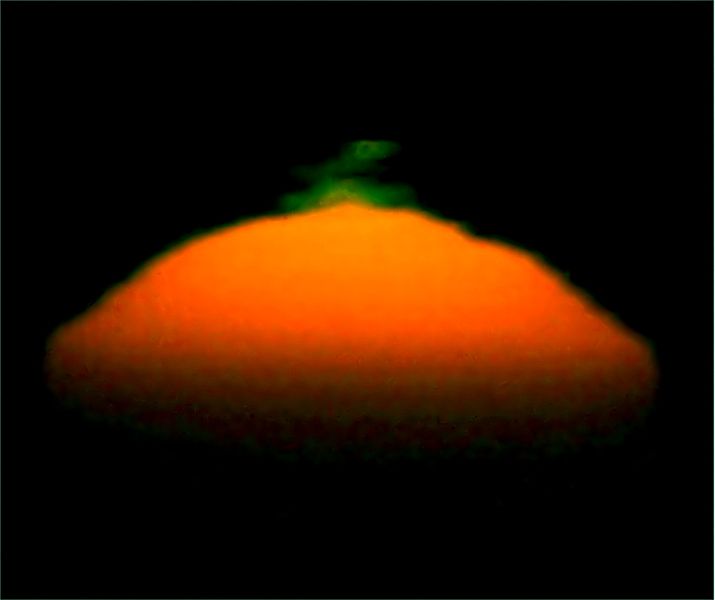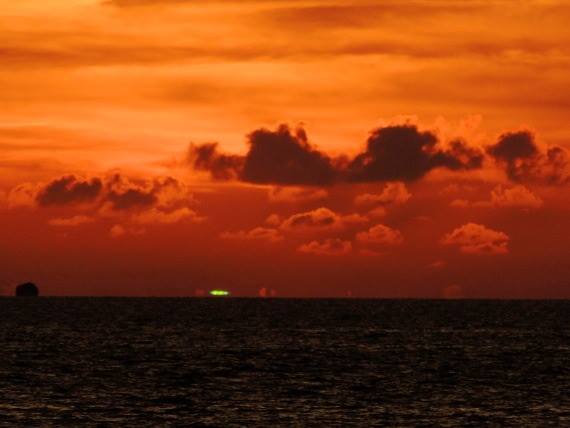

Green flash over the North Sea, Belgium. Image via Hans Hillewaert.
Help EarthSky keep going! Please donate what you can to our annual crowd-funding campaign.
People tell me when I go to the beach to look at the sunset to try to see a green flash. What is a green flash?
The green flash is an optical phenomenon that you can see shortly after sunset or before sunrise. It happens when the sun is almost entirely below the horizon, with the barest edge of the sun – the upper edge – still visible. For a second or two, that upper rim of the sun will appear green in color. It’s a brief flash of the color green – the legendary green flash. It’s really quite exciting to see, especially if you’ve been looking for one.
It’s said that once you’ve seen a green flash, you’ll never again go wrong in matters of the heart.
Jim Grant photographed this green flash on April 27, 2012, off the coast of San Diego.

Green flash on setting sun observed from a mountain. Image via Amiteshomar/Wikimedia Commons.
Green flash atop sun pyramid via Colin Legg.
How can you see a green flash? You just need two things:
1. A clear day with no haze or cloud on the horizon.
2. A distant horizon – and a distinct edge to the horizon. You can see the green flash from a mountaintop or high building. But it’s most often seen over the ocean, by people on beaches or in boats.
Important tip: Don’t look at the sun until it is nearly entirely below the horizon. If you do, you will dazzle (or damage) your eyes and ruin your green flash chances for that day.
Since you need to know exactly where to look along the horizon, and since most of us aren’t up before dawn, green flashes are most often seen after sunset. But diligent observers can see them before dawn, too. And, although they’re most often seen over the ocean, you can see green flashes over land, too, if your horizon is far enough away.
What is the green ray? The flash can be like a flame that shoots above the horizon. In that case, it’s called a green ray. I’ve seen lots of green flashes, but never a green ray, although I was once walking on a beach in Mexico and turned away just as my companion saw one. I did not find any photos of flamelike green rays (if you know of one, let me know), but the photo below suggests the beginnings of a ray.

Mock mirage (explained at Atmospheric Optics) and green flash seen from San Francisco. Image via Mila Zinkova/Wikimedia Commons.
What makes a green flash? The green flash is the result of looking at the sun through a greater and greater thickness of atmosphere as you look lower and lower in the sky. Water vapor in the atmosphere absorbs the yellow and orange colors in white sunlight, and air molecules scatter the violet light. That leaves the red and blue-green light to travel directly toward you. Near the horizon, the sun’s light is highly bent or refracted. It’s as though there are two suns – a red one and a blue-green one – partially covering each other. The red one is always closest to the horizon, so when it sets or before it rises, you see only the blue-green disk – the green flash.
Enjoying EarthSky? Sign up for our free daily newsletter today!

The elusive green flash just after sunset on July 29, 2014 in the East China Sea. Image via EarthSky Facebook friend Mike Quinn.
Little green flash on upper rim of the sun at sunset on November 4, 2012, captured by EarthSky Facebook friend Jim Grant in San Diego.
Bottom line: How to see the elusive green flash.
from EarthSky https://ift.tt/2TBuuwc


Green flash over the North Sea, Belgium. Image via Hans Hillewaert.
Help EarthSky keep going! Please donate what you can to our annual crowd-funding campaign.
People tell me when I go to the beach to look at the sunset to try to see a green flash. What is a green flash?
The green flash is an optical phenomenon that you can see shortly after sunset or before sunrise. It happens when the sun is almost entirely below the horizon, with the barest edge of the sun – the upper edge – still visible. For a second or two, that upper rim of the sun will appear green in color. It’s a brief flash of the color green – the legendary green flash. It’s really quite exciting to see, especially if you’ve been looking for one.
It’s said that once you’ve seen a green flash, you’ll never again go wrong in matters of the heart.
Jim Grant photographed this green flash on April 27, 2012, off the coast of San Diego.

Green flash on setting sun observed from a mountain. Image via Amiteshomar/Wikimedia Commons.
Green flash atop sun pyramid via Colin Legg.
How can you see a green flash? You just need two things:
1. A clear day with no haze or cloud on the horizon.
2. A distant horizon – and a distinct edge to the horizon. You can see the green flash from a mountaintop or high building. But it’s most often seen over the ocean, by people on beaches or in boats.
Important tip: Don’t look at the sun until it is nearly entirely below the horizon. If you do, you will dazzle (or damage) your eyes and ruin your green flash chances for that day.
Since you need to know exactly where to look along the horizon, and since most of us aren’t up before dawn, green flashes are most often seen after sunset. But diligent observers can see them before dawn, too. And, although they’re most often seen over the ocean, you can see green flashes over land, too, if your horizon is far enough away.
What is the green ray? The flash can be like a flame that shoots above the horizon. In that case, it’s called a green ray. I’ve seen lots of green flashes, but never a green ray, although I was once walking on a beach in Mexico and turned away just as my companion saw one. I did not find any photos of flamelike green rays (if you know of one, let me know), but the photo below suggests the beginnings of a ray.

Mock mirage (explained at Atmospheric Optics) and green flash seen from San Francisco. Image via Mila Zinkova/Wikimedia Commons.
What makes a green flash? The green flash is the result of looking at the sun through a greater and greater thickness of atmosphere as you look lower and lower in the sky. Water vapor in the atmosphere absorbs the yellow and orange colors in white sunlight, and air molecules scatter the violet light. That leaves the red and blue-green light to travel directly toward you. Near the horizon, the sun’s light is highly bent or refracted. It’s as though there are two suns – a red one and a blue-green one – partially covering each other. The red one is always closest to the horizon, so when it sets or before it rises, you see only the blue-green disk – the green flash.
Enjoying EarthSky? Sign up for our free daily newsletter today!

The elusive green flash just after sunset on July 29, 2014 in the East China Sea. Image via EarthSky Facebook friend Mike Quinn.
Little green flash on upper rim of the sun at sunset on November 4, 2012, captured by EarthSky Facebook friend Jim Grant in San Diego.
Bottom line: How to see the elusive green flash.
from EarthSky https://ift.tt/2TBuuwc


Aucun commentaire:
Enregistrer un commentaire